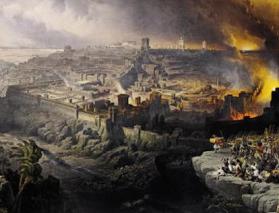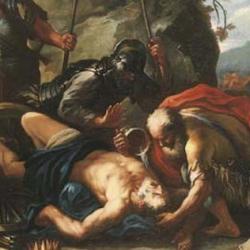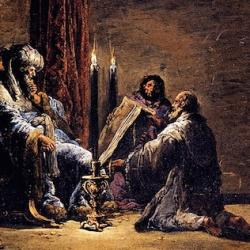Hezekiah “completes” a Passover (2 Chronicles 31:1a), then starts breaking things. He continues until the destruction is also “complete” (2 Chronicles 31:1b; Heb. kalah). He breaks pillars, cuts down Asherim, and pulls down high places and altars.
Hezekiah’s purge is described in a single complex verse, 2 Chronicles 31:1:
A. After they completed all this [Passover celebration]
B. all Israel went out
C. to the cities of Judah
D. and shattered pillars, cut Asherim, pulled down high places and altars
C’. in Judah, Benjamin, Ephraim, Manasseh
A’. until they completed.
B’. Then all the sons of Israel
C’. returned each to his own city.
With this spree of destruction, Hezekiah joins Judah’s royal All Stars: Good kings in Judah are always destroyers of idols. Asa, Joash, Hezekiah, Josiah are each “new Joshuas” who purge the land of false worship. Finally, Nebuchadnezzar comes on the scene as the final new Joshua, cleansing the land by destroying Jerusalem’s temple, which has become no better than a shrine to Baal.
Though Hezekiah is a destroyer, the Chronicler portrays his actions as creative. The verb kalah, which frames 2 Chronicles 31:1, provides an initial clue. It’s the verb used to describe the “completion” of heaven and earth (Genesis 2:1–2), and the completion of the microcosmic tabernacle (Exodus 40:33) and temple (2 Chronicles 7:11). The description of the destruction contains three verbs (shatter, cut, pull) and four objects (pillars, Asherim, high places, altars), a sevenfold destruction that is a prerequisite to sevenfold recreation. Solomon was given royal wisdom and skill to build the temple; Hezekiah and the other heroes of destruction exercise royal wisdom in destroying idolatry.
Hezekiah’s creative destruction is unique. Besides him, only Asa destroys four manifestations of idolatry (cf. 2 Chronicles 14:3). Only Hezekiah’s purge is carried out by “all Israel” (2 Chronicles 31:1), the renewed and reunited people who celebrated the Passover, and only Hezekiah’s purge extends beyond Judah and Benjamin into the northern territories of Ephraim and Manasseh. All Israel is deployed to all Israel to carry out Hezekiah’s program of recreative destruction.
Destruction is, of course, not the end but the beginning. After shattering, cutting, and pulling down, Hezekiah “makes-stand” the priests and Levites, re-installing them as liturgical leaders at the temple (31:2). He supplies ascension and peace offerings for daily and periodic sacrifices (31:3), and calls the people of Jerusalem and Israel to contribute goods to supply the temple services (31:4–5). The collection begins in the third month and stretches to the seventh (!) month, when the “heaps” of goods are “founded” and “completed” (31:7; kalah again).
The complete sevenfold destruction prepares for the completion of the re-establishment of temple worship, completed in the seventh month. Creative destruction gives way to creative construction.














